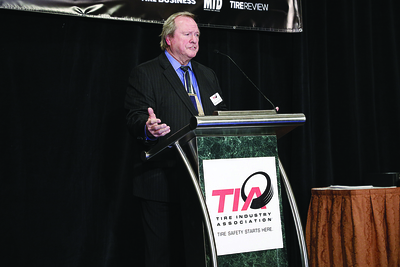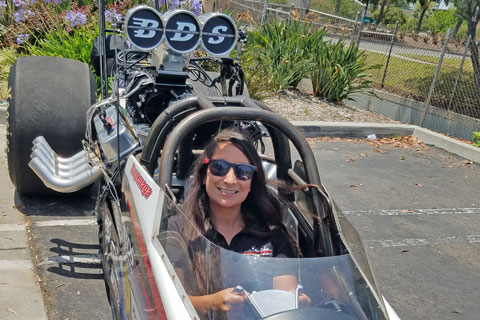INDUSTRY INSIDER
10 Questions for Dick Gust
By Douglas McColloch
 When the subject of conversation turns to tires, few industry experts can speak with as much authority as Dick Gust. The current CEO of the Tire Industry Association (TIA), Gust started his decades-long career while still in college, and upon graduation was hired as a design engineer with Uniroyal. He subsequently spent time in a variety of managerial roles with Sears Roebuck, Lakin Environmental and Liberty Tire Recycling, where he served as director of government affairs. He has worked with a number of industry associations, including the National Tire Dealers & Retreaders Association, American Retreaders Association and International Tire & Rubber Association. He has also served on the U.S. Department of Commerce’s Environmental Technologies Trade Advisory Committee.
When the subject of conversation turns to tires, few industry experts can speak with as much authority as Dick Gust. The current CEO of the Tire Industry Association (TIA), Gust started his decades-long career while still in college, and upon graduation was hired as a design engineer with Uniroyal. He subsequently spent time in a variety of managerial roles with Sears Roebuck, Lakin Environmental and Liberty Tire Recycling, where he served as director of government affairs. He has worked with a number of industry associations, including the National Tire Dealers & Retreaders Association, American Retreaders Association and International Tire & Rubber Association. He has also served on the U.S. Department of Commerce’s Environmental Technologies Trade Advisory Committee.
For our annual tire and wheel issue, we spent some time with Gust to “talk tire.” What follows has been edited for clarity and length.
SEMA News: What’s your latest project? What are you working on these days?
Dick Gust: We’re working on gaining more membership, and we’re working on increasing our training programs that are our bread and butter. We really are a safety association, and it’s time that we updated a few of our training programs, so that’s our big push right now. To give two examples, we’re working on an earth-mover program, and we’re translating our commercial tire training materials into Spanish.
SN: What was your first job in the industry, and what did you learn from it?
DG: It was a summer job working at a Uniroyal tire plant in Eau Claire, Wisconsin, to pay for my college. I was a tire builder, so I learned the business from the drum up. After I graduated, Uniroyal offered me a job in their product development department. So that job gave me the best background in knowing how a tire comes together.
SN: What has pleased you most about this industry during the time you’ve spent in it?
DG: I think it always comes down to the people. It’s a very close-knit industry. People may move around from one company to another, but their enthusiasm for tires always goes with them. I haven’t worked in other industries, but I know this one’s pretty special in terms of
camaraderie.
SN: Tire manufacturers are starting to look at domestic tire production using non-rubber agricultural products, such as dandelions, to address supply-chain and sustainability issues. What potential impact do you think this could have on the industry and on the
consumers?
DG: Manufacturers are looking long-term at less reliance on overseas rubber plantations and more on various sustainable products that they can incorporate domestically into the construction of a tire. When the materials don’t have to be transported overseas, that’s going to positively impact the supply chain, but certainly not in the next few years.
SN: The retread industry has faced challenges in recent years. What do they have to do to stay competitive?
DG: A lot of the retread companies have been purchased by major tire manufacturers, and they’re recognizing that it’s a great sustainable product. One of the challenges they’ve had, though, is with tires that are coming in from the Far Eastern countries—China, for example—and some of those tire casings are not suitable to be retreaded. Additionally, the price for a new tire in China is so inexpensive that it makes selling retreads into that market difficult. But I think over time this problem will work itself out.
SN: What’s your daily driver and what do you like best about it?
DG: I drive a Jeep Grand Cherokee. I’ve owned four of them previously, and I just think it’s a terrific car.
SN: Let’s talk about electric vehicles (EVs) for a moment. They pose unique challenges on tires. How is the industry responding? And what can consumers expect down the road?
DG: We’ve created an electric-vehicle advisory council, and we’ve pulled together some experts within the industry to look at a lot of different things. EVs have a lot more weight than ICE vehicles, so from the tire perspective, tires for EVs are going to wear out faster. So, the manufacturers are looking at materials for these tires that make them longer-wearing and with better rolling resistance.
SN: As you mentioned, TIA is all about safety. Could you talk a bit about what you think the industry in general could do to improve safety protocols?
DG: Right now, we’re looking to emphasize the commercial tire industry a lot more. Many people who handle commercial truck tires don’t realize that it’s an OSHA requirement to be trained to do so. If you touch a commercial truck tire, you are required by OSHA to be trained. So we’re trying to aim our training programs more toward the commercial side of the business.
SN: If you went back to school, what would you study?
DG: I have a degree in chemistry, and at one point I thought about becoming a doctor. So I’d probably go back into some kind of medical field.
SN: When you’re away from work, where will you be, and what will you be doing?
DG: My wife and I are new to the East Coast now, so we spend time venturing out on weekends looking at historic sites in the Washington, D.C., area. We have a vast array of museums here, so you might find us at a museum on the weekend.



